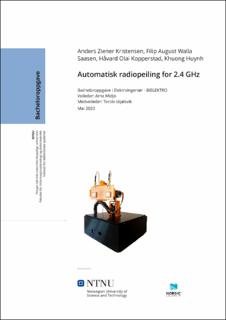Automatisk radiopeiling for 2.4 GHz
Bachelor thesis
Permanent lenke
https://hdl.handle.net/11250/3004425Utgivelsesdato
2022Metadata
Vis full innførselSamlinger
Sammendrag
Radiopeiling er en teknikk innenfor radiokommunikasjon som tar i bruk ulike applikasjoner for mottakelse av radiobølger til å orientere seg mot en senderkilde. Ved å ta i bruk et antennearray kan målinger i fase- og motfase brukes for å detektere endringer i signalstyrken ved orientering mot senderantennen. Prosjektet går ut på å designe og konstruere en passende mottakerantenne for systemet, designe og dimensjonere robotarmen som skal styre antennen og utvikle en algoritme for styring av robotarmen og databehandling. Innretningen anvender Bluetooth Low Energy som nettverksprotokoll og opererer på 2.4 GHz. Ved undersøkelser av eksisterende teknologi innenfor fagområdene utledes det en fungerende prototype av et radiopeilingssystem, som gjennom empirisk testing kan danne et grunnlag for en estimator for nøyaktigheten til radiopeilingen. Direction finding is a technique within RF-communication that uses different applications for reception of radio waves to determine the direction of the beacon. By measuring the signals in an antenna array in phase and anti-phase, the sum-difference between the respective signals can be used to detect beacons by rotating the antenna in the azimuth- and elevation plane. The goal for the project is to design and construct an antenna array with the applicable characteristics, design and dimension the robot arm holding and orienting the receiver antenna and develop a program code for the search algorithm and data processing. The application utilizes the Bluetooth Low Energy as the network protocol and operates on 2.4 GHz. By researching the existing literature within the field of science, a functioning direction finding prototype was developed. Through empirical testing and observation, an estimator for the accuracy of the direction finding is derived.
